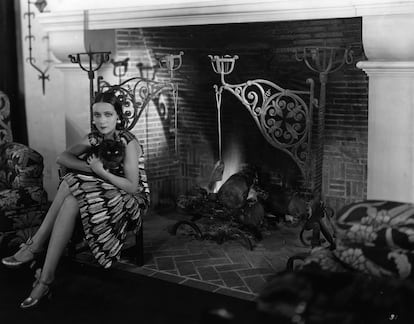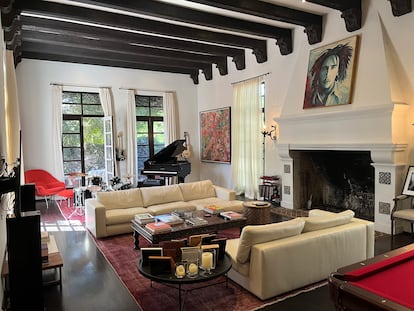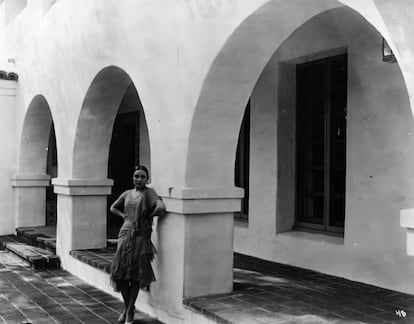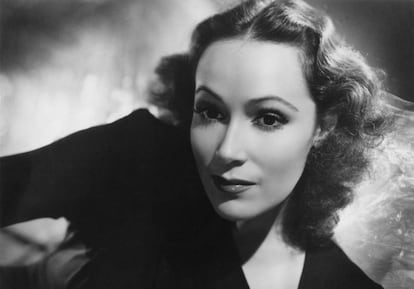The home where Dolores del Rio hosted Hollywood parties in the 1920s is now a cultural heritage site
One of the first Latinas to succeed in the movie industry, the star’s Los Angeles mansion is commemorated


The daily parties at 1903 Outpost Street in Los Angeles were a big part of the notorious 1920s Hollywood social life. The address is where the former home of Dolores del Rio, one of the first Latin Americans to make it big in the film industry, still stands. One such star-studded party took place on July 21, 1928 with Charlie Chaplin, Greta Garbo, Andrés de Segurola (the Spanish baritone turned movie star), Samuel Goldwyn, D. W. Griffith and many others in attendance. The press called it “one of the most extravagant parties of the summer,” a grand send-off for del Rio who would leave days later for Europe.
The Mexican government recently unveiled a plaque to commemorate the 1926 mansion’s place in Los Angeles cultural history. The city listed it as a heritage site late last year, but no ceremony was held until the couple who now own the house opened their doors for the celebration. Built in the foothills of northwest Hollywood by architects Ross Castendyck and Milton Black, the expansive home’s five bedrooms and bathrooms were frequently mentioned in the entertainment press. More importantly, it was where the del Rio legend began. She later sold the home to a former Minnesota congressman for $70,000. Other owners have included actor Ken Kercheval (from the TV soap opera Dallas), and Australian fashion designer, Richard Tyler. The current owners bought the home in 2015 for $4.4 million.
Nearly a century later, the house is more notable for its well-preserved Spanish colonial architecture than for its floor plan. The exterior features classic white stucco walls, a clay tile roof, and a courtyard with Andalusian (southern Spain) arches and red-tiled floor. The interior staircases, doorways and alcoves decorated with Mexican hand-painted tiles are still in perfect condition. The actress commissioned Mexican artisans to create a mosaic of the Virgin of Guadalupe with decorative Talavera (Puebla, Mexico) ceramic tiles next to one of the mansion’s entrances. In its application to designate the del Rio house a cultural monument, historic preservation consulting firm Historic Resources Group wrote, “Del Rio commissioned the construction of the property and was actively involved in its design. She resided there for five years as she made her name as an actress.”

After attending a Christmas party in the home, a January 1928 column by Grace Kingsley, the first Los Angeles Times film critic, reads, “The living room is a wonderful, restful place, luxuriously furnished in Mexican style… It has the largest fireplace I have ever seen.” A Hawaiian band entertained the guests, but the most exciting moment of the evening was when the Christmas tree caught fire. The tree was dragged outside before the ruby-red upholstered furniture could catch fire by actors Harry Wilson (a mob film regular), Warner Baxter (the Cisco Kid of westerns), and actor/bandleader Buddy Rogers.
The house at 1903 Outpost Drive was del Rio’s first home in the United States. Born in Durango (central Mexico), Dolores Martínez Asúnsolo y López Negrete was discovered in 1925 by Edwin Carewe, an influential American producer and director who had spotted her dancing a tango at a private party in Mexico City. At age 16, she married Jaime del Rio, a Mexican businessman 18 years her senior. It was rumored that Carewe, the love of her life, caused the breakup of Dolores’ marriage just as her film career was taking off.
In 1926, director Raoul Walsh cast del Rio in his box-office hit, What Price Glory, and a year later she won her first leading role. Over the next four years, del Rio made 15 silent movies, but she was often typecast as indigenous or exotic characters. She overcame the limitations of her thick accent during the transition to sound films when she became one of the first actresses to wear a daring two-piece bathing suit in Flying Down to Rio, the 1933 film that featured Fred Astaire and Ginger Rogers dancing together for the first time.

In 1928, she was hired for Ramona, directed again by Carewe, and received excellent reviews for her performance in the title role. Shortly after filming was completed, she moved into the home on Outpost Drive with her husband and threw a Mexican-themed party to celebrate. She sang the film’s theme song for the guests, which became a radio hit in April 1928, according to entertainment historian Myra Nye.
Del Rio, who died in 1983 in California, divorced her first husband shortly after her film career took off. Her second marriage to Cedric Gibbons, an MGM studio art designer, lasted for 11 years, during which the couple moved to Malibu (California) and then to the Pacific Palisades area near Los Angeles.

After divorcing Gibbons, her relationship with Orson Welles, 10 years her junior, became public and the two were engaged while he was directing Citizen Kane. Welles and del Rio worked together in Journey into Fear, a commercial and critical flop that triggered the separation of the volcanic couple. She married for the third and last time in 1959 to television producer Lewis Riley, with whom she stayed until his death.
After breaking off her relationship with Welles, del Río returned to Mexico in 1943 where she helped cement the reputation of Mexican cinema. That same year she starred in María Candelaria, directed by Emilio “El indio” Fernández. The film won the Palme d’Or at Cannes, and was often cited by del Rio as her favorite role. She later appeared in Spanish-language classics such as Roberto Gavaldón’s La otra.
Due to her public support of socialist exiles from the Spanish Civil War, del Rio was denied permission to work in the US during the McCarthyism of the 1950s, causing her to lose a role as Spencer Tracy’s wife in Broken Lance to Katy Jurado, who was later nominated for an Oscar for her work in the film. In 1956, her political situation in the US was resolved and del Rio was able to return to the place that made her famous. Today, the house on Outpost Drive still stands as a monument to the first Mexican woman to make it big in Hollywood.
Tu suscripción se está usando en otro dispositivo
¿Quieres añadir otro usuario a tu suscripción?
Si continúas leyendo en este dispositivo, no se podrá leer en el otro.
FlechaTu suscripción se está usando en otro dispositivo y solo puedes acceder a EL PAÍS desde un dispositivo a la vez.
Si quieres compartir tu cuenta, cambia tu suscripción a la modalidad Premium, así podrás añadir otro usuario. Cada uno accederá con su propia cuenta de email, lo que os permitirá personalizar vuestra experiencia en EL PAÍS.
¿Tienes una suscripción de empresa? Accede aquí para contratar más cuentas.
En el caso de no saber quién está usando tu cuenta, te recomendamos cambiar tu contraseña aquí.
Si decides continuar compartiendo tu cuenta, este mensaje se mostrará en tu dispositivo y en el de la otra persona que está usando tu cuenta de forma indefinida, afectando a tu experiencia de lectura. Puedes consultar aquí los términos y condiciones de la suscripción digital.
More information
Últimas noticias
Most viewed
- Sinaloa Cartel war is taking its toll on Los Chapitos
- Oona Chaplin: ‘I told James Cameron that I was living in a treehouse and starting a permaculture project with a friend’
- Reinhard Genzel, Nobel laureate in physics: ‘One-minute videos will never give you the truth’
- Why the price of coffee has skyrocketed: from Brazilian plantations to specialty coffee houses
- Silver prices are going crazy: This is what’s fueling the rally










































